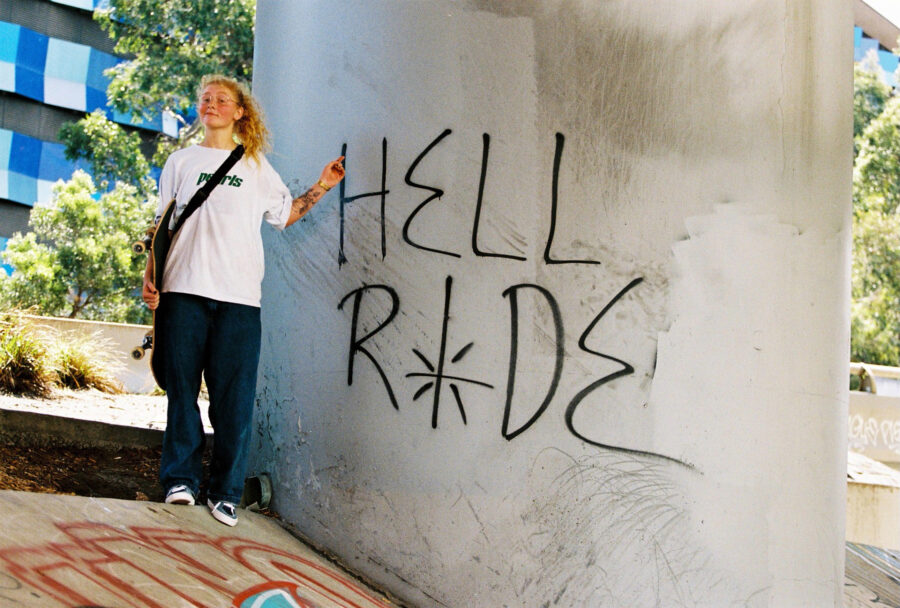
Interview by Farran Golding / Photography by Norma Ibarra
Straight after speaking to Shari White, I hopped on a call with her roommate and Credits opener, Una Farrar.
Una is cheerful, insightful and appreciative; personality traits which became apparent minutes into our conversation. Although, receiving Krooked boards personally advocated by skateboarding’s patron saint of stand up folks – Jim Thiebaud, is a character endorsement which says it all, really.
Read on to learn about how the crew of Credits came together, why you should embrace cannonballs and glean some wisdom about staying positive when life throws a curveball.
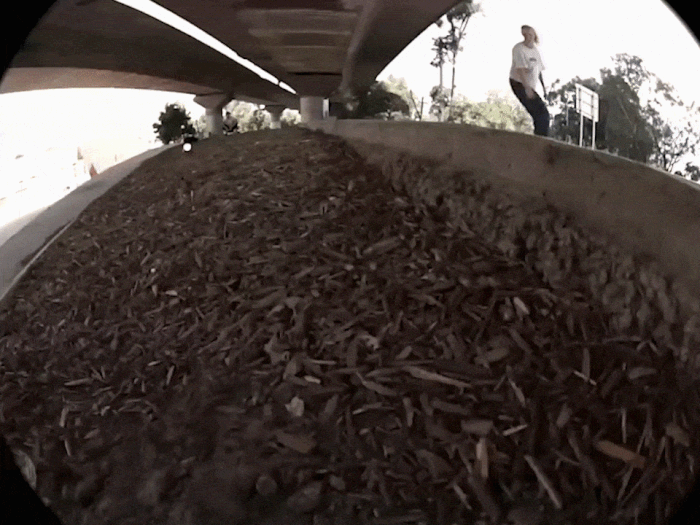
The speed wobble on impact makes this one however the astute skate geeks will clock the relevance of that graffiti in Una’s portrait… Beanplant from Credits
I heard you liked reading skateboarding magazines before you started skating. Were you flicking through U.S. stuff back then or was it Canadian mags like SBC?
It was whatever was in the skate shop, the little free ones, or what my brother had. Canadian ones like SBC, Concrete and obviously Thrasher was around. My parents would always get me and my brother a magazine each at Christmas as a stocking filler so they’d grab me a skiing one and him a skate one. They’d probably think to look for a local publication [laughs].
So you skied, and snowboarded a little, before you started skating and still do both, right?
Yeah, not very seriously but I’ve been doing it for a while. It’s the only thing my family does all together. Every year we do one family thing, to call it a “skiing holiday” makes it sound like some luxury shit but it was always pretty budget [laughs]. On the island I grew up on [Vancouver Island] there’s a mountain we’d go up to for the holidays when we were younger.
The “if you skate you can snowboard” thing is lost on me. I’m so bad at snowboarding.
It’s sketch. Don’t get me wrong, I’m more of a skier than a snowboarder too. My parents had me on skis when I was a baby so I grew up thinking it was comfortable. It was only recently that I got back into snowboarding again. [Doing it now] after starting skating, I could figure it out and through being able to ski I was comfortable enough to go fast. But it’s annoying, you catch edges, you’re always sitting down to put bindings on… That’s a privileged complaint! [Laughs]. I’m still a skier at heart.
Do you think you liked skating because there were any similarities to skiing, except skating was more accessible?
No, they give me two different feelings. With mountain sports you can go fast, go big and slam in the snow and it doesn’t really hurt that much. Skating was more of a technical challenge. It involved setting challenges for myself or playing S.K.A.T.E. against my friends. Whereas with skiing, I don’t know, it’s weird because they’ve both brought me a lot of joy but completely different kinds.
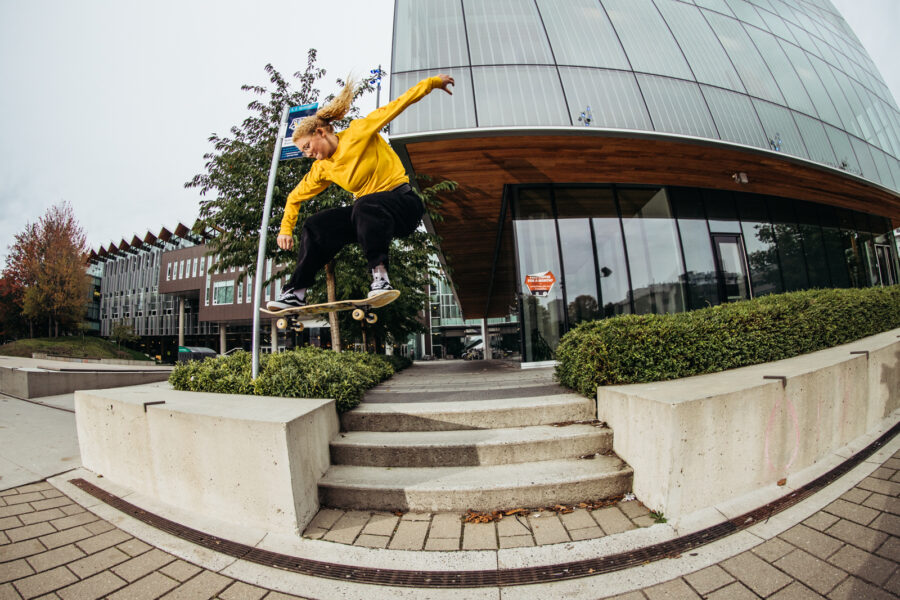
So many hang-up factors in play here. ph: Ibarra
You built a backyard ramp with your dad back in the day, did it take much to convince him?
It did take a lot of convincing. We didn’t have a lot of money but my parents made things work if we showed a lot of interest in something. One of my friends had a ramp and I watched him and his dad build it. My friends and I would skate it everyday so I knew how to build it and explained it to my parents step by step. What we needed, where we could put it… How great it would be for me and friends [laughs]. Over and over again I’d mention it to them and my dad finally gave in.
We built it using the exact same dimensions as my friend’s ramp, like eight feet wide by four feet high and 24 feet long. Whenever we’d have people over for a little BBQ the mini-ramp was so entertaining. There’d be the homies skating, which was cool, then we’d have random people who would want to drop in on it. People would see it, they’d see the opportunity, and they’d slam so hard. One of my friends broke her arm but other than that it would just be the typical drop-in slam.
Can you give me some background on Lyrics, your first shop sponsor, and the impact it had on your life?
It was open for a year, or less, but it was my first sponsor and I got sponsored by them after winning the “intermediate” category of a contest in my hometown. The local skatepark had people who worked there in the summer, like park supervisors, from 10 ’til 5. The city basically gave two skaters a job to watch out over the park, make sure people weren’t drinking and they were trained in first aid incase anybody got hurt.
One of the guys, Eddy, was so sick. He was so involved with all the kids, he knew everyone and filmed videos at the park every summer. He started the shop about 50 metres away from the the park in this little mall plaza. It was called Lyrics because it was a recording studio and a skate shop. They’d make white rap music which was kind of, like, “Yeesh…” [Laughs]. I think it’s still a recording brand.
Everyone involved was my friends from my hometown. It didn’t last because it was literally just skateboarders and their parents going in there which was a little bit of money but not enough.
Shout outs to Eddy. He changed a lot of kids’ lives, actually. He was a skater, who had partied and whatever growing up, but when he got that park supervisor role he looked out for all those kids who turned up to the park everyday because they didn’t have anywhere else to go. He made these videos called “Dub Love” – it was Victoria West Park so “Dub” stood for W – like five years in a row. We’d premiere them at the end of the summer in the local theatre, which was sick, because if your clip made it in the video then you got to see yourself on the big screen.
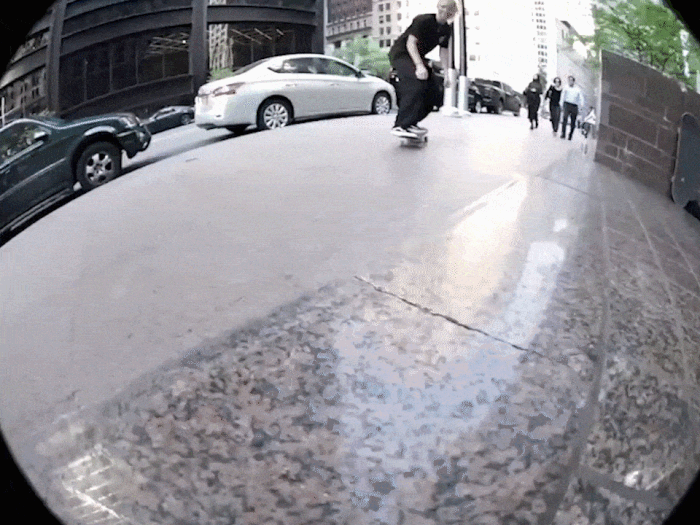
Credits
When you input VX footage into editing software the audio is always peaking in the red and you have to bring it down. I’ve always liked that, it’s a multi-sense thing.
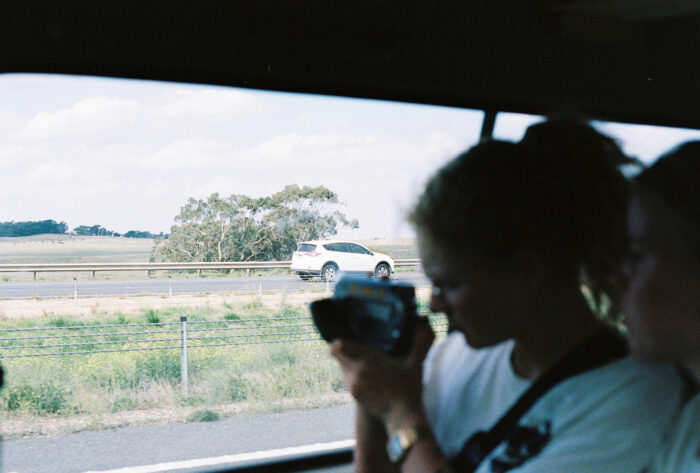 You’re handy with a VX. Have you always been just as interested in videos and filming?
You’re handy with a VX. Have you always been just as interested in videos and filming?
My friends who got me into skating got me into filming at the exact same time so I always thought they went together. I really like filming and skate videos but I don’t know how “handy” I am with a VX, I learn something new about it every time I pick the fuckin’ thing up [laughs]. I think I take something from every video I watch. Every time I capture a clip I realise something’s not quite right so I apply it to the next time I’m filming.
It was normal to be that kind of skate nerd in my little friend group. I didn’t know much but, from watching videos, I’d know what camera they were filming with. One of my biggest inspirations was Beagle, he made skating and filming look so fun. It was a big Baker/Deathwish time period so I just thought, “I want to film like Beagle.”
Every time my homie got a better camera, I’d get a hand-me-down one but Beagle made us want to get VXs. We had all these mini-handicams leading up to a VX. Someone would have a GO1, someone would have a TRV900, someone would have a Panasonic. They all cycled through our friend group but a VX was always the end goal.
Where do you sit on the VX vs HD debate?
I fully sit on the VX side but I don’t mind certain HD footage. People can make it look good. Shari’s set-up is probably my favourite, the 4:3 HD. The other kinds are too wide, and the sound is all weird – like they’re underwater or far away – but her set-up was really cool. I’d never seen it before and she had the VX mic on it through a little extension so the sound was good too.
There’s some grit to a VX mic which compliments the footage.
I think that’s one of the reasons it was discontinued, because the mic was too sensitive and prone to breaking. It was used for family home videos and budget movies so it was good for picking up sound that was directly in front of the camera but when newer cameras started being made it was with the intention of picking up sound from everywhere so you’ve got the whole feel of your environment.
With skateboarding you want that directness from the microphone, right? You don’t want to hear the filmer’s wheels, you want to hear the skateboarder’s wheels. When you input VX footage into editing software the audio is always peaking in the red and you have to bring it down. I’ve always liked that, it’s a multi-sense thing. It looks nice but it sounds nice too.
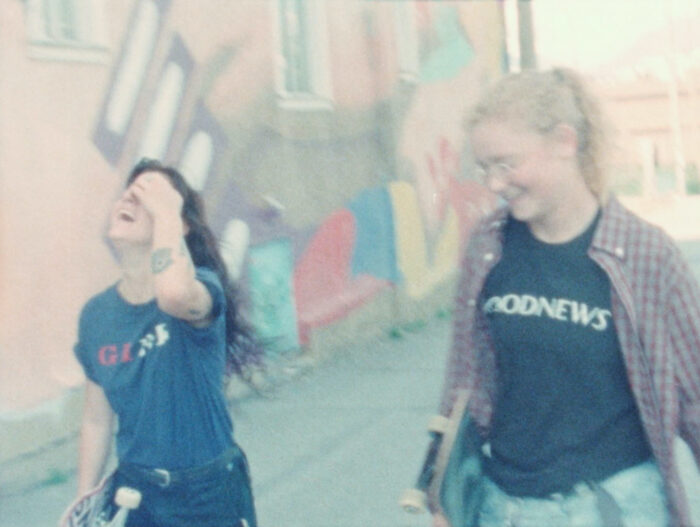
Breana Geering and Una from Credits / photos inset above and below by Norma Ibarra
Give us a run down on Wheels of Fortune, the women’s comp where you got to know Breana, Fabiana and Shari.
I don’t remember where I heard about it, maybe Instagram. It was a huge. I’d see this big group of women visiting Seattle every May and I thought, “What is this?” My parents got stoked on it so we drove down to it that year because there wasn’t many women’s contents, or events in general, so when there is you usually hear about it through word of mouth.
 We checked that one out, I want to say I was 17, and I met Breana for the first time. We’d been talking on Instagram for a bit. We were two girls who skated in our area, and there wasn’t that many, but we’d never met. It was hilarious right off the bat. Fabi and Pedro [Delfino] were there, and we got on the same Witch Hunt team so we were skating together. We all clicked right away and by the end of that weekend it felt like we’d been friends for years but we’d only known each other for like four days.
We checked that one out, I want to say I was 17, and I met Breana for the first time. We’d been talking on Instagram for a bit. We were two girls who skated in our area, and there wasn’t that many, but we’d never met. It was hilarious right off the bat. Fabi and Pedro [Delfino] were there, and we got on the same Witch Hunt team so we were skating together. We all clicked right away and by the end of that weekend it felt like we’d been friends for years but we’d only known each other for like four days.
How’s it been seeing Wheels of Fortune grow over the years?
It’s inspiring. It’s growing to a point where I don’t know what Shari and Krisiten [Ebeling] are going to do, it’s going to get hectic. You see new faces every time.
Any standout moments from most the recent one?
So many, it’s hard to narrow down. The last two years have been sponsored by Thrasher so something which stood out, this year, was that we got a Thrasher article and I had a full page photo doing a stupid cannonball [laughs]. Shari and Kristen showed us a bunch of skaters they hang out with to make challenges based around them. Breana’s was shotgunning something while doing a manual and mine was to do a cannonball. Nobody did it because cannonball’s suck and they’re scary to learn but they’re really easy. I did one over my girlfriend, Poppy and Alex White and Norma took a photo of it which it ended up as the full page in Thrasher.
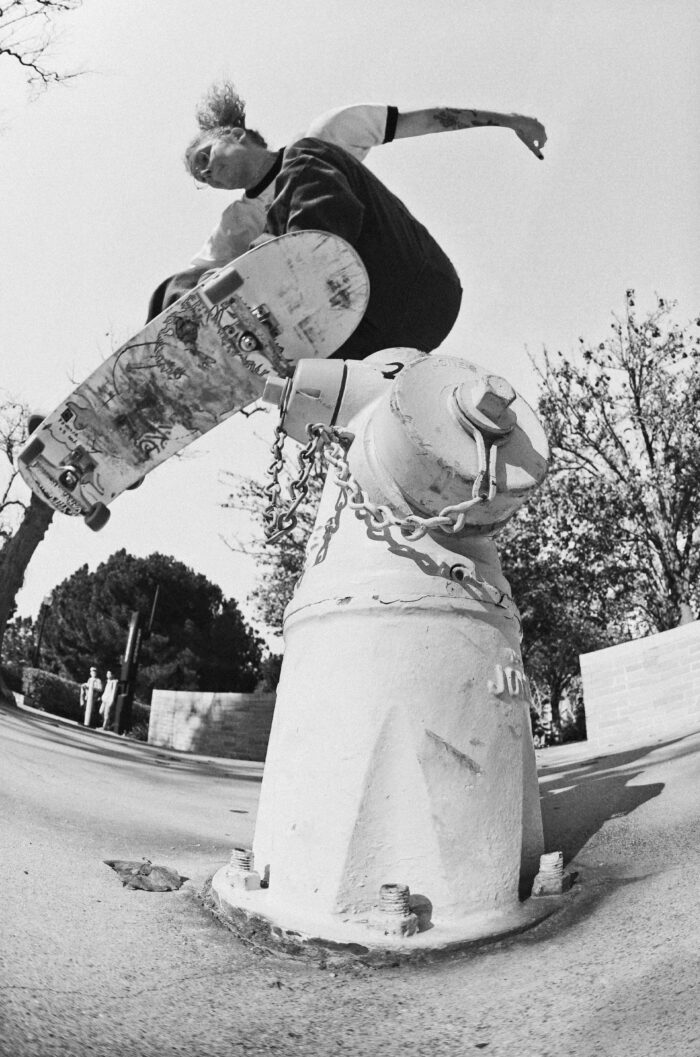
Hydrant hopping for Shari White’s lens and into The Skate Witches #14. Inset below – chuck-on nosegrind, ph: Ibarra
You busted your ACL in New York early on into filming for Credits. What’s the story there?
That was a nine-stair handrail which was way too steep for the trick I was trying. Well, actually, no it wasn’t!
Kyota [Umeki] who rides for Frog took us to that rail. I wanted to hit a handrail and it was the last day or so. We went, I started trying it and I was basically gapping out to the last foot of it and shooting into the ground because it was so steep. I thought if I went a little slower, and got on one step higher, I could ride out of it.
On the third try of committing to it I slammed into the ground, my back foot came off the board and I sat back on it. I didn’t hear a pop or anything, because I didn’t tear it – which was nice, but I knew I’d fucked something up. I was scared to get up.
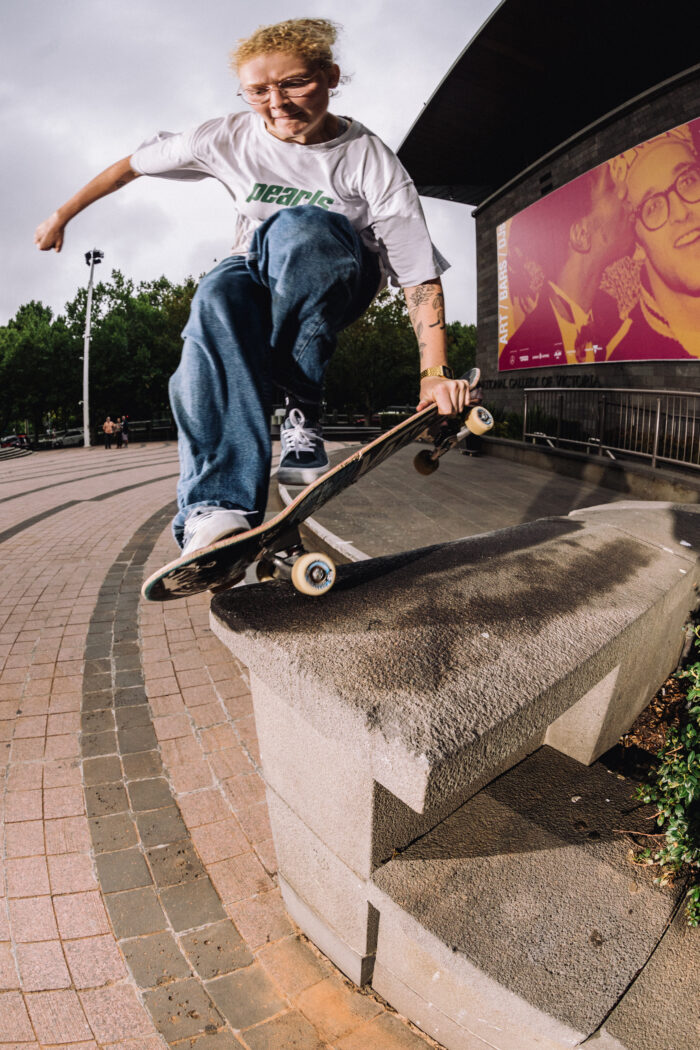 Of all the times not to take a cannonball.
Of all the times not to take a cannonball.
I know! Oh, that’s what I was getting around to: Kyota posted a clip of him front boarding it which proves you can do that trick on that spot and I just blew it. I kept blaming it on the rail being too steep and then he did the exact same trick. Motherfucker [laughs].
How’d you pass the time for the last bit of the trip? A mix of tourism and skate spot tourism?
Yeah, we did a lot of that. I got hurt on the second to last day so I was skating up until that point. We were doing, as you say, “skate spot tourism”. Going to a spot, not filming anything and just staring at it or sitting there for half an hour, talking about everything that’s been done and then leave [laughs].
When I hurt my knee, Frank [Mare] our TM, asked if I wanted to go to the hospital. It hadn’t swollen or locked up, and I could still put weight on it, so we got these little crutches.
“Frank, we’re in New York. It’s the last day and I’m bummed because I blew out my knee.”
“Okay, well do you want to go up the Empire State Building?”
He hooked it up for everyone to go up to the top and it was so sick. I was up there, on crutches, and we saw Times Square. It was really bright, because we went up there at night, so I was like, “I want to go there next!” and Frank just had to give in because I was so broken off and pathetic [laughs]. There’s a photo of me holding up these crutches in Times Square I want to find. The next day we went home and I was right into physio.
How did you find the recovery process?
It was frustrating but rewarding. I had a cool physio who was smart and would come up with new exercises every time. I remember Frank telling me about how when Ronnie Sandoval blew his knee out he put as much effort into rehab as he would put into skateboarding if he had been healthy. Just being as obsessive, so I tried to do that. Every day I’d go out to do physio exercises like I’d be going out to skate, tried to eat healthy and rode my bike.
Were you still going on trips to hang out and film a little bit too?
Yeah, I could put weight on it for the remainder of that one trip but they did the next two to S.F. and Montreal without me. Then we had a trip to Miami and they started bringing me back. Well, they invited me before but I wasn’t able to. When Miami came around I started going again, kind of as a filmer. I don’t know if it was for my sake or for other peoples’, to break up pressures, but being included helped a lot while I was injured. I don’t know if any of my second angles got used. Maybe it was just: “Una’s going insane, let’s get her back.”
Mentally overcoming that was the hardest thing but I think it has made me stronger in the long run and more grateful for being able to do what I do.
As much as it must have sucked, was it motivating at all after the fact? Obviously, you’re going to be excited to skate again and then you’re racing against the deadline a little more than the others.
It definitely motivated me in ways I haven’t felt before because I’d never had a serious injury like it. I’m still scared to this day even though I’m fully recovered. I still think it could go all the time.
The deadline of the video had an effect for sure. I was anxious to get back into it but I had to pace myself. I blew it on the front board and I really wanted to get another front board before the end of that video, which was a one year turnaround. I ended up getting one in Melbourne, it’s like a two second clip, but I was stoked.
Mentally overcoming that was the hardest thing but I think it has made me stronger in the long run and more grateful for being able to do what I do. Before, it wasn’t necessarily getting to my head but you do get in the zone where you’re, not less appreciative, but maybe don’t realise how good you’re getting it until it’s taken away.
Sounds like a humbling experience.
Definitely. It was definitely humbling.
Were you still happy with your part in the end?
As happy as a skateboarder can be. There are always tricks you want to get, harder things you want to film, those lingering thoughts of “I should’ve have done this trick there.” I’m pretty proud of it, and I’m really proud of Breana and Fabi. I’m just stoked to be a part of that and hopefully this is just the start and we can keep filming videos from here on.
You’ve had a few parts already but does Credits feel like a debut in a way?
It feels like a debut on corporate side, maybe, because every video part I’ve made before now was either by myself or a genuinely “just for the homies” video vibe which wasn’t being paid for by anyone or where I’ve been flown anywhere, you know?

Frontside boardslide for personal redemption. ph: Ibarra
How does the scene in Vancouver compare to Vancouver Island where you grew up?
It’s really cool, actually, in some of the same ways and some different ways. I’ll always appreciate my hometown scene and everything there but there are a lot of new things here too. I skated with women for the first time here and the women’s scene is still growing, the queer scene is really accepting, there are indigenous activists. It’s cool because it’s bigger city vibes, where you have a melting pot of a lot of different people, as opposed to a small town where everybody knows everybody.

Wallie to 5050 with the crew in Melbourne. ph: Ibarra
You travelled a lot over the course of Credits. Could you see yourself living in any of those cities or is there anywhere in general you’d like to relocate to for a little bit?
I’d be down to spend some time in Australia but I’m a bit of a homebody. I like Vancouver and this area, it’s got a lot to offer. Also, with the privilege of being able to travel, it’s nice that I can live here and go to Montreal or California. Nowhere is too far, which is great, but if I couldn’t travel maybe I’d want to live in California or somewhere else. I like living up here, the States is fucked.
What’s the usual day-to-day when you’re not skating?
Kind of the same stuff like filming and editing. I’ve definitely been forced into the crafty side due to the quarantine. When it’s normal, it’s usually physio because I’m always hurt, trying to bike somewhere or do yoga.
Skateboarding is the main pillar so everything revolves around it. Filming skateboarding, making art that’s related to skateboarding, it’s all consuming [laughs]. I just dove head in, I was interested in other things before I found skateboarding but from there it was like, “Oh, the art in skating is cool, the music is cool, the videos are cool.” Everything I wanted to be involved in was right there.
I’ll see other skaters’ side projects and be inspired that they’re doing something other than skating. Mark Gonzales’ art, Alexis Sablone’s animations or someone making stuff out of old skateboards, just seeing someone do something else will make me think I can do other stuff too and then I’ll start messing around. It always comes full-circle.
The more effort you put into recovering the more your body will repay you
From dealing with injuries over the last year, I guess you’re accustomed to things being a little different and worrying. Any words of wisdom on how to keep a good mindset when life isn’t exactly running smoothly?
I find myself in that situation a lot. It’s like, keep your head up because it’s temporary. That’s what you’ve got to keep in mind. It will end, eventually, and with injuries the more effort you put into recovering the more your body will repay you. With times like this, where we just have to sit tight, it’s keeping in mind that it’s not going to last forever. That’s what I’m telling myself everyday.
Anything you want to throw out there to wrap this up?
I love everyone involved with Credits and props to Shari because she had an insane workload. For a project like this, which wasn’t ever planned and it snowballed as we were doing it, I feel like you’d normally have two filmers or a filmer and an editor. She covered every base and was so calm and collected. So I just wanted to point that out. She had a super hard job and did it really well.
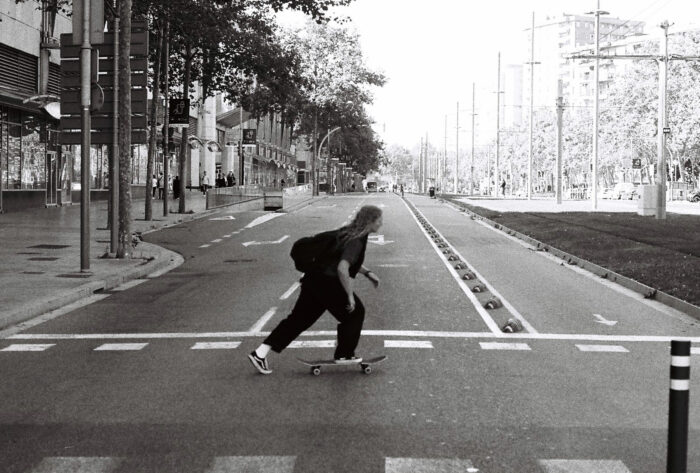
ph: Ibarra
More from our Credits interview series: Shari White – “All the pieces of the puzzle.” / Fabiana Delfino – “Just go out there and film.” / Breana Geering – “If I be myself, I think it’ll be okay.”

